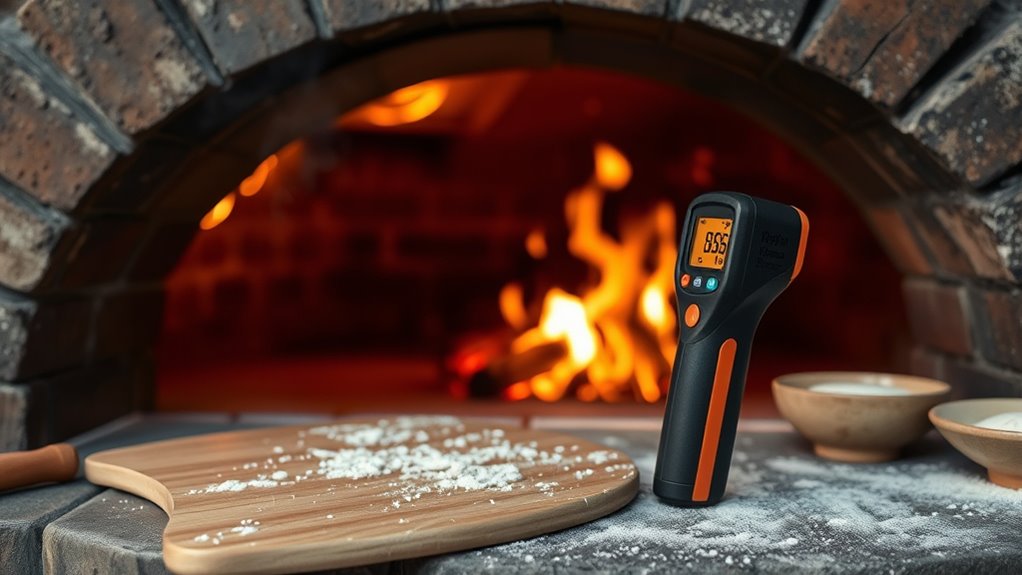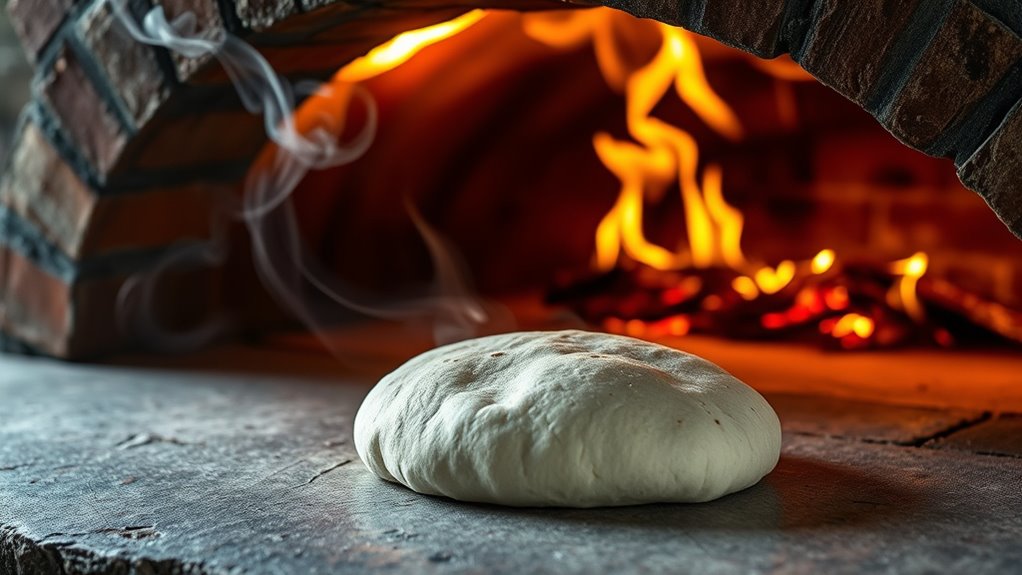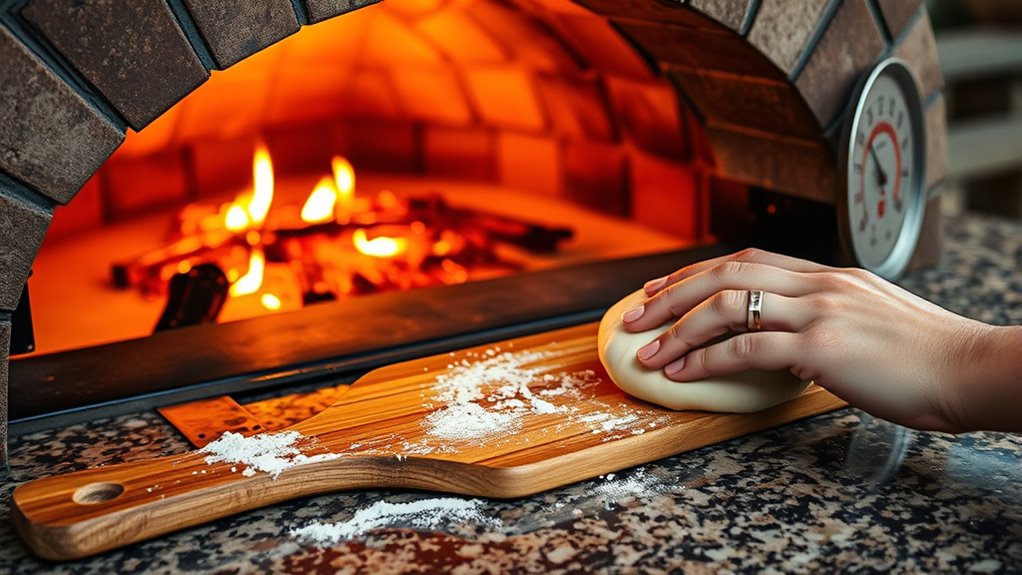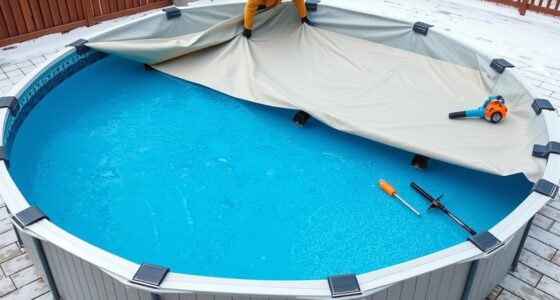To master your outdoor pizza oven, focus on maintaining a temperature between 700°F and 900°F for crispy crusts and thorough cooking. Use an infrared thermometer to monitor surface heat regularly, adjusting vents and fire as needed for even heat distribution. Proper preheating and careful dough handling, including using quality ingredients and gentle shaping, help guarantee consistent results. Keep practicing, and you’ll discover more tips to perfect your pizza-making skills.
Key Takeaways
- Maintain oven temperatures between 700°F and 900°F for crispy, evenly cooked pizza crusts.
- Use infrared thermometers to monitor surface temperatures and identify hot spots for consistent heat.
- Preheat the oven gradually with seasoned wood, focusing on even heat buildup before baking.
- Control airflow with vents and keep the fire centered to ensure uniform heat distribution.
- Use high-quality flour and proper dough fermentation techniques for an evenly baked, flavorful crust.
Understanding Optimal Temperature Ranges for Pizza Cooking

To achieve perfect pizza, understanding the ideal temperature range is essential. Most professional and home outdoor pizza ovens operate best between 700°F and 900°F. At these temperatures, the high heat guarantees the crust gets crispy on the outside while remaining chewy inside. If the oven isn’t hot enough, the dough may cook unevenly, resulting in a soggy or underdone crust. Conversely, if it’s too hot, the toppings could burn before the crust is fully cooked. The key is to maintain a consistent temperature within this range to achieve a well-balanced bake. Monitoring your oven’s heat and adjusting fuel or airflow accordingly helps you hit that sweet spot for delicious, evenly cooked pizza every time. Proper temperature management is crucial for achieving consistent results and avoiding common pitfalls like burnt toppings or undercooked crusts. Additionally, understanding how to control temperature stability ensures the oven remains within the optimal range throughout the cooking process, leading to better overall results. Incorporating regulation techniques can help maintain steady heat, especially during longer cooking sessions, since temperature fluctuations can cause uneven cooking and affect the final quality of your pizza.
Using a Infrared Thermometer to Monitor Your Oven’s Heat

An infrared thermometer provides you quick and precise temperature readings of your oven’s surface, so you can keep the heat just right. With this tool, monitoring your oven becomes fast and effortless, helping you avoid hot spots or uneven cooking. Using it regularly guarantees your pizza cooks perfectly every time. Additionally, understanding the trustworthiness and vulnerabilities of your thermometer helps ensure accurate readings and safe operation. Regular calibration and proper handling are essential to maintain its measurement accuracy over time. For wireless models, keeping the Bluetooth connection stable is also crucial for consistent readings. Being aware of industry trends can help you select the most reliable infrared thermometers suited for outdoor pizza ovens. Being aware of personal finance management practices can help you budget for quality tools like infrared thermometers, ensuring you invest wisely.
Accurate Temperature Reading
Using an infrared thermometer to monitor your outdoor pizza oven’s heat guarantees you get an accurate reading of the surface temperature quickly and easily. This tool measures the infrared radiation emitted by the oven’s interior surfaces, giving you real-time data without contact. To verify precision, aim the thermometer at different spots inside the oven, particularly the cooking surface and the dome, as temperatures can vary. Keep the device steady and at the proper distance, usually specified by the manufacturer, to avoid inaccurate readings. Regularly checking temperatures helps you maintain consistent heat levels, essential for achieving perfect pizza crusts. Remember, surface temperature doesn’t always match air temperature, so use these readings as a guide to optimize your cooking process. Incorporating temperature monitoring techniques can further enhance your control over the oven’s heat and improve your results. Understanding heat distribution within your oven can help you identify hot spots and ensure an even cook every time. Additionally, being aware of appliance maintenance can prevent unexpected issues that might affect your oven’s performance. Regularly cleaning and inspecting your oven components can help maintain optimal temperature accuracy and prolong the lifespan of your equipment.
Quick Monitoring Technique
When you need to quickly check your outdoor pizza oven’s temperature, an infrared thermometer is a handy tool. It allows you to instantly read surface temperatures without opening the door, helping you avoid heat loss. Simply point the device at different areas of the oven floor or dome for accurate readings. Use the table below to understand typical temperature zones:
| Zone | Temperature Range |
|---|---|
| Oven Floor | 700°F – 900°F |
| Dome Interior | 800°F – 900°F |
| Air Layer Above Oven | 700°F – 850°F |
| Pizza Surface | 600°F – 700°F |
This quick method helps you maintain ideal heat levels, ensuring perfect pizza results every time. Infrared thermometers are increasingly used in modern culinary equipment to optimize performance and consistency.
Preheating Your Outdoor Pizza Oven for Best Results

Before baking, you need to properly preheat your outdoor pizza oven to guarantee the best results. Using the right firewood type helps achieve consistent heat and smoky flavor, while a thorough warm-up promotes even cooking. Focus on heating the oven evenly for perfect crusts and toppings every time. Incorporating performance tuning techniques can further optimize your oven’s heat distribution and baking outcomes. Additionally, understanding cost and budgeting aspects of maintaining your oven can ensure you allocate resources effectively for ongoing performance. Proper preheating also minimizes side effects of improper heating, such as uneven baking or burnt crusts, ensuring a superior pizza experience. Embracing advanced AI-driven tools in oven design could also enhance temperature control and precision. Leveraging AI applications in learning may help in developing smarter heating systems that adapt to specific baking needs.
Proper Oven Warm-Up
To achieve the perfect pizza crust and toppings, you need to preheat your outdoor pizza oven properly. Start by igniting a small fire using dry, seasoned wood to generate initial heat. Gradually add more wood to increase the temperature, allowing the oven to heat evenly. Keep the door or lid slightly ajar during the warm-up to let excess moisture escape and promote consistent heat buildup. Use a infrared or surface thermometer to monitor the internal temperature, aiming for around 700-900°F (370-480°C) for authentic Neapolitan-style pizzas. This slow, steady warm-up ensures the oven’s walls and floor reach ideal baking temperatures, preventing cold spots. Proper preheating reduces cooking time and helps you achieve a well-cooked crust with perfectly melted toppings. Regularly check your bicycle tire pressure during the warm-up process to ensure even heat distribution and consistent baking conditions. Additionally, maintaining the correct temperature control is essential for achieving optimal cooking results. Incorporating proper insulation techniques can also help maintain even temperatures throughout your baking session. Being aware of local resources and tools, such as temperature monitoring devices, can further enhance your preheating efficiency.
Use of Firewood Type
Choosing the right firewood is essential for achieving ideal heat and flavor in your outdoor pizza oven. The type of wood you select impacts burn time, heat consistency, and the smoky profile of your pizza. Hardwoods like oak, hickory, and maple burn longer and produce steady, high heat, perfect for preheating. Softwoods such as pine or cedar ignite quickly but burn faster and can add unwanted resin or harsh flavors. Using seasoned wood—dry and properly stored—ensures cleaner combustion and better heat. Avoid green or wet wood, which creates excess smoke and reduces oven efficiency. Proper firewood choice helps you reach optimal temperatures faster, maintains steady heat, and enhances your pizza’s taste with the right smoky aroma.
Achieving Even Heat
Using the right type of firewood helps your oven reach the desired temperature efficiently, but achieving even heat across the cooking surface is equally important for perfect pizzas. To do this, build a gradual fire that spreads heat evenly, starting with small kindling and gradually adding larger logs. Keep the flames low initially to warm the oven thoroughly without creating hot spots. Once the desired temperature is reached, use a long-handled brush or peel to move hot embers and redistribute heat. Avoid rushing the preheat process; patience guarantees consistent warmth. Rotating your pizza during cooking also helps expose it to uniform heat. Properly preheated and evenly heated ovens produce crisp crusts and perfectly cooked toppings every time.
Managing Flame and Airflow for Consistent Heat Distribution

Controlling the flame and airflow is essential for maintaining a consistent heat inside your outdoor pizza oven. Proper management guarantees your pizza cooks evenly without burning or undercooking. To do this effectively, you need to adjust the fire size and position, regulate the vents, and monitor the airflow. Here are some tips to help you master this:
- Use a chimney or vent damper to control oxygen flow and regulate the fire intensity.
- Keep the fire centered to promote even heat distribution across the cooking surface.
- Adjust the door or intake vents to fine-tune airflow, preventing hotspots and maintaining consistent temperature.
Selecting and Preparing the Perfect Pizza Dough

To make a great pizza, you need to start with the right dough, which forms the foundation of your creation. Choose a high-quality flour, like bread or 00 flour, for better texture and flavor. Use warm water and a pinch of sugar or honey to activate the yeast, ensuring your dough rises properly. Mix ingredients thoroughly, then knead until smooth and elastic—this develops gluten for a chewier crust. Let the dough rest and rise in a warm spot until it doubles in size, usually about 1-2 hours. Proper preparation includes dividing and shaping the dough with care, avoiding overworking it. Fresh, well-prepared dough will give you a sturdy base that cooks evenly and yields a delicious, crispy crust.
Techniques for Achieving the Ideal Dough Texture and Thickness

Achieving the perfect dough texture and thickness hinges on your technique during shaping and handling. To get it just right, focus on gentle pressure and even distribution. Use your fingertips to press outward from the center, avoiding too much force that can thin the dough unevenly. Rotate the dough as you shape it to maintain a consistent thickness. Keep the dough slightly thicker at the edges for a crust, and thinner in the center for a crispy bite. Remember, patience is key—don’t rush the process.
Gentle, even pressing and rotating ensure perfect dough thickness and texture.
- Use a rolling pin or your hands to control uniform thickness
- Avoid over-handling to prevent tearing or dense spots
- Rest the dough after shaping to relax gluten and improve texture
Tips for Handling Dough During Assembly and Transfer to Oven

Handling your dough carefully during assembly and transfer is crucial to prevent it from tearing or losing its shape. Start by dusting your work surface and hands with a light layer of flour or semolina to prevent sticking. Gently lift the dough using a wide, flat spatula or your hands, supporting its edges to maintain its shape. When transferring to the pizza peel or baking surface, do so smoothly and confidently to avoid stretching or tearing. If the dough resists, give it a moment to relax. Avoid pressing down or forcing it, as this can cause tears. With patience and gentle handling, your dough will transfer seamlessly, ensuring a perfectly shaped base ready for toppings and baking.
Troubleshooting Common Temperature and Dough Issues

Temperature and dough issues often arise because of inconsistent conditions or improper techniques, leading to problems like dough not rising properly, tearing, or baking unevenly. To troubleshoot, focus on maintaining stable heat and proper dough handling.
- Make sure your oven reaches and maintains the right temperature before baking.
- Use a thermometer to monitor the oven’s heat for consistent results.
- Adjust dough hydration and kneading to prevent tearing and promote proper rise.
Frequently Asked Questions
How Does Outdoor Weather Affect Pizza Oven Temperature Accuracy?
Weather conditions can considerably impact your outdoor pizza oven’s temperature accuracy. Cold temperatures cause heat loss, making it harder to reach and maintain high temperatures. Wind can disrupt heat distribution, leading to uneven cooking. Humidity may affect how your dough bakes. To get consistent results, you should preheat your oven thoroughly, shield it from wind, and monitor the temperature regularly, adjusting your cooking time as needed.
What Safety Precautions Should I Follow When Operating an Outdoor Pizza Oven?
Safety is your main ingredient when operating an outdoor pizza oven. Think of it as the secret sauce—protect yourself and others. Always wear heat-resistant gloves and keep a fire extinguisher nearby. Make sure the area is clear of flammable materials, and never leave the oven unattended while in use. With these precautions, you can enjoy cooking safely and confidently, creating delicious pizza without any risks.
Can Different Types of Wood or Fuel Impact Oven Temperature Control?
Different types of wood or fuel definitely impact your outdoor pizza oven’s temperature control. Hardwoods like oak or maple burn hotter and longer, giving you more consistent heat. Softwoods like pine burn faster and produce more smoke, which can make temperature regulation tricky. Using the right fuel helps you maintain the ideal cooking temperature, ensuring your pizza cooks evenly and perfectly every time.
How Often Should I Calibrate My Infrared Thermometer for Accuracy?
Ever wonder how often you should calibrate your infrared thermometer? You should do it at least once a year or whenever you notice inconsistent readings. Calibration guarantees your temperature measurements stay accurate, helping you perfect your pizza crusts. Keep an eye on the thermometer’s performance, especially after drops or rough handling. Regular calibration keeps your oven’s temperature just right, so your pizzas turn out perfect every time.
What Are the Signs of Dough Overworking or Underworking During Preparation?
When checking your dough, look for signs of overworking or underworking it. Overworked dough becomes tough, develops tough gluten strands, and resists stretching. Underworked dough, on the other hand, feels too soft, sticky, and tears easily when shaped. If your dough is too elastic or resistant, it’s overworked; if it’s too slack or sticky, it’s underworked. Properly mixed dough should be smooth, elastic, and easy to shape.
Conclusion
Mastering your outdoor pizza oven comes down to controlling temperature and perfecting your dough. Did you know that ideal oven temperatures between 700-800°F can cook a pizza in just 90 seconds? By monitoring heat, preheating properly, and handling dough with care, you’ll consistently get delicious results. With practice, you’ll turn out pizza that’s crispy on the outside and perfectly chewy inside—making every backyard gathering a true pizza party.










